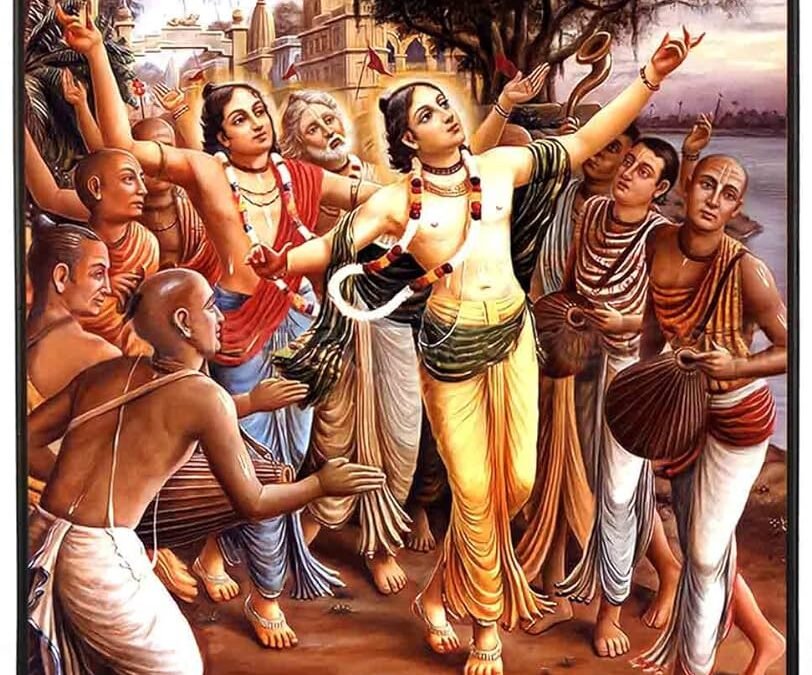Mahatama Gandhi is known for having started the movement of nonviolent civil disobedience in India, but about five hundred years before him, Shri Caitanya Mahaprabhu started His movement of nonviolent civil disobedience to the order of Chand Kazi the then magistrate of Nabadwip district of West Bengal. It is not necessary to commit violence to stop the opposition from hindering a movement, for one can kill their demoniac behavior with reason and argument.
Sriman Chaitnya Mahaprabhu after marriage began to preach the congregational chanting of the Holy Name of the Lord at Nabadwipa. Some of the Brahmins became envious of His popularity and put many hindrances in His path. At last these Brahmins complained about the matter before the Muslim Magistrate at Nabadwipa. Bengal was then governed by Pathans and the Governor of the Province was Nawab Hussain Shah. The Muslim Magistrate of Nabadwipa took the complaints of the Brahmins seriously, and at first he warned the followers of Nemai Pandit (Lord Chaitanya) not to chant the Name of Hari loudly. But Lord Chaitanya asked His followers to disobey the orders of the Kazi and they went on with their Samkirtan party as usual. The Magistrate then sent constables and broke some of the Mrindangams (drums) which were being used in Kirtan.
When Nemai Pandit heard of this incident, he organized a civil disobedience movement at Nabadwipa. He is the pioneer of the civil disobedience movement in India for the right cause. He organized a procession of one hundred thousand men with thousands of Mrindangams, and the procession passed over the roads of Nabadwipa without any fear of the Kazi who had issued the order. At last the party reached the house of the Kazi, who went upstairs out of fear of the mass movement. The men, assembled there at the house of the Kazi, showed a haughty disposition, but the Lord asked them to be peaceful. At this time the Kazi came down and pacified the Lord by addressing Him as his nephew. He said that Nilambar Chakrabarty was called by him “Chacha”, or “uncle,” and as Srimati Chachidevi the mother of Nemai Pandit became his sister. He asked Nemai Pandit whether a sister’s son can be angry with his maternal uncle. Why should be not be respected? In this way, the whole incident was mitigated, and there was a long discussion of the Koran and Hindu Shastras between the two learned scholars.
The question of cow-killing was also raised by the Lord and they properly replied with reference to the order of Koran. The Kazi also questioned the sacrifice of cows mentioned in the Vedas, and the Lord replied that the sacrifice of cows mentioned in the Vedas is not considered cow-killing. In that sacrifice an old bull or cow is sacrificed to give it a fresh, younger life by the power of the Vedic Mantra. In the Kali Yuga (the present age of discontent) such cow sacrifice is forbidden on account of the absence of learned Brahmins able to conduct such ceremonies. In the Kali Yuga, therefore, all Yajnas (sacrifice) is forbidden because it is a useless attempt by foolish men. In the Kali Yuga only the Samkirtan process is recommended for all practical purposes. The Kazi was convinced, and he became a follower of the Lord. He declared that thenceforward no one was to hinder the Samkirtan Movement started by the Lord. The Kazi’s crematorium is still existent within the area of Nabadwipa, and all Hindu pilgrims go there to show their respects. The Kazi’s descendants were residents of Nabadwipa, but they never objected to Samkirtan, even during the days of the Hindu-Muslim riots.
Source: Back to Godhead; March 1st, 1967 | Tags: Chand Kazi, Civil Disobedience Movement, Hindu, Koran, Muslim Riots | Category: Lord Caitanya, Volume-01 Number-09
Posted 10th February 2015 by Anonymous
